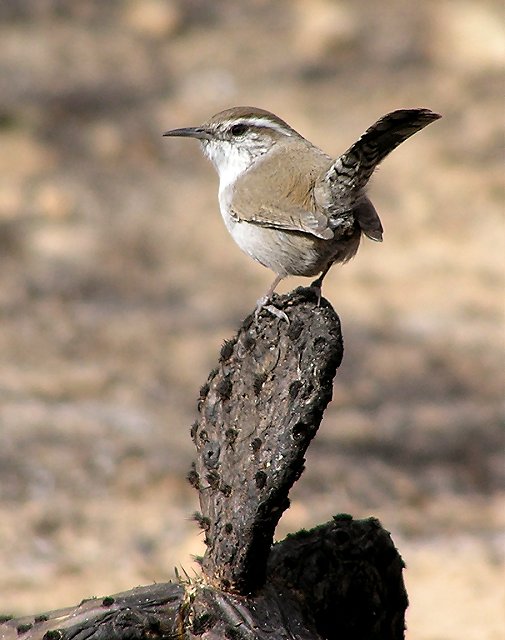- Thryomanes bewickii
Identification
L. 12–13·5 cm (4¾-5¼ in) Ws. 18.4cm (7.25in)
- Overall drab color
- Grays in the West; browns in the East
- Unmarked, lighter underside
- White to gray
- Long barred tail
- Decurved bill
- White eyebrow
Similar Species
Similar to Carolina Wren
Distribution
Throughout the SW quadrant and Pacific Coastal regions of the U.S., extending deeply into central Mexico. Much less common east of the Mississippi, with dramatically declining populations extending to the Appalachian mountains.
Taxonomy
A study shows genetic divisions within this species possibly indicating a future split.
Subspecies
In the order of 15 geographically separate subspecies have been documented[1]; two went extinct in the early 1900s from predation and habitat destruction.
bewickii Group
- T. b. bewickii: Eastern North America, from northeastern Kansas and southern Iowa east to southern Ontario and central Pennsylvania, south to northern Arkansas, northern Alabama, and central South Carolina; but extirpated from most of its range east of the Mississippi River
mexicanus Group
- T. b.i eremophilus: East California to Utah, Wyoming, west Texas and west-central Mexico
- T. b.i cryptus: Eastern Colorado south through western Oklahoma and western Texas to northeastern Mexico (northern Nuevo León)
- T. b.i pulichi: Central United States, in Kansas, Oklahoma, and presumably north central Texas, and east, perhaps, to Missouri; mostly resident, but some winter in south central Texas and perhaps northeastern Mexico
- T. b.i sadai: Southernmost Texas and northeastern Mexico (south to central Tamaulipas)
- T. b.i mexicanus: Central Mexico (Jalisco to western Veracruz, south to south central Oaxaca)
spilurus Group
- T. b. calophonus: South-western British Columbia to western Washington and western Oregon
- T. b.i drymoecus: South-western Oregon to California (Sacramento and n San Joaquin valleys)
- T. b. marinensis: Coastal California (Del Norte County to Marin County)
- T. b. spilurus: Coastal central California (San Francisco to Monterey Bay)
- T. b. leucophrys: Formerly San Clemente I. (off southern California). Extinct; last reported in 1941
- T. b. charienturus: Southwestern California (north to Morro Bay), including the northern Channel Islands, and northwestern Baja California, Mexico
- T. b. cerroensis: West-central Baja California (30° to 26°N) and Isla Cedros
- T. b. magdalenensis: Southern Baja California south of 26ºN
- T. b. brevicauda: (Extinct ca 1903): Formerly Guadalupe Island (off Baja California)
Habitat
Open country; mixed scrub, grass, and wooded areas.
Behaviour
A relatively tame and conspicuous bird, it allows close approach, and is comfortable in man-made environments, often nesting in cavities provided by structures.
Diet
Their diet consists almost entirely of insects.
Breeding
Vocalisation
Two birds in conversation
Recording by SanAngelo
San Angelo State Park, North Unit, Texas, July 2016
References
- Clements, J. F., T. S. Schulenberg, M. J. Iliff, D. Roberson, T. A. Fredericks, B. L. Sullivan, and C. L. Wood. 2017. The eBird/Clements checklist of birds of the world: v2017, with updates to August 2017. Downloaded from http://www.birds.cornell.edu/clementschecklist/download/
- Paper describing genetic findings with this species
- Handbook of the Birds of the World Alive (retrieved August 2016)
Recommended Citation
- BirdForum Opus contributors. (2025) Bewick's Wren. In: BirdForum, the forum for wild birds and birding. Retrieved 11 May 2025 from https://www.birdforum.net/opus/Bewick%27s_Wren
External Links
Search the Gallery using the scientific name:
Search the Gallery using the scientific name:
GSearch checked for 2020 platform.




